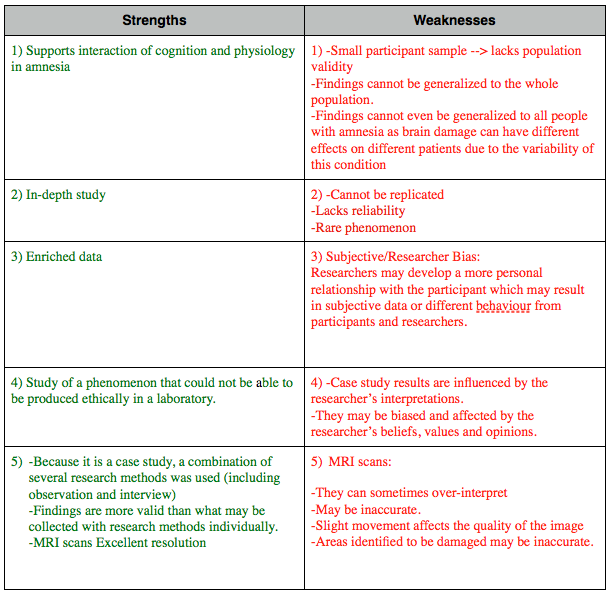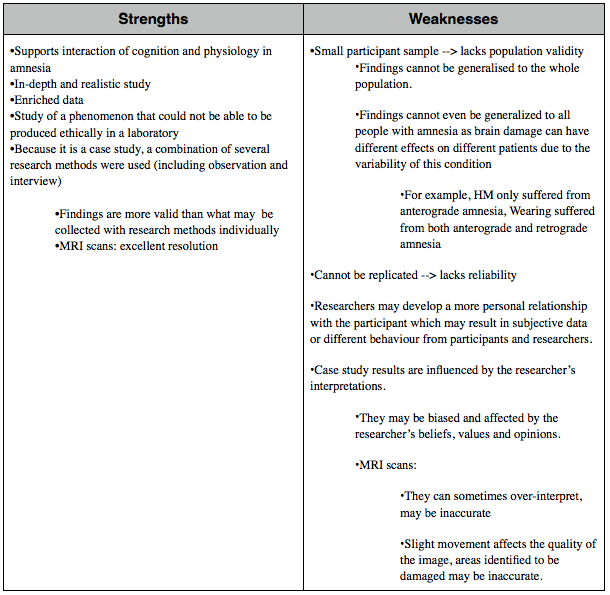Examine one interaction between cognition and physiology in terms of behaviour.
Introduction
- State what you are doing in the essay
- This essay will attempt to uncover the assumptions and interrelationships of the interaction between cognition and physiology in terms of amnesia.
- Define cognition and physiology
- To examine the interaction between cognition and physiology in terms of amnesia, one must first understand that:
- Cognition is the mental process of acquiring and processing knowledge and understanding through thought, experience and the senses. Cognitive processes include perception, attention, language, memory and thinking.
- Physiology is the internal, biological mechanisms of living organisms – the way the organism functions
- Define amnesia
- Amnesia can be defined as the inability to learn new information or retrieve information that has already been stored in memory.
- Amnesia is the condition in which people lose their ability to memorize/recall information.
- Outline amnesia
- There is an interaction between biological and cognitive factors in amnesia
- Amnesia has a biological cause (e.g. brain damage) and affects cognition (e.g. memory)
- In amnesia patients, episodic memory is affected to a greater extent than semantic memory.
- Episodic memories are memories linked to a certain time and place.
- Semantic memories are memories for the meaning of information.
- State causes of amnesia
- Amnesia can be caused by brain damage through:
- injury
- strokes
- infections
- specific drugs – usually sedative
- Closed head injuries
- Bilateral strokes
- Chronic alcoholism leads to Korsakoff’s syndrome
- Regions affected in the brain:
- Diencephalon (subcortical)
- Medial temporal lobe (cortical)
- Hippocampus
- Amnesia may also be a symptom of some degenerative diseases, such as Alzheimer’s disease.
- State the different types of amnesia
- Neuroscientists distinguish between two key types of amnesia, anterograde and retrograde:
- Anterograde Amnesia
- Impairment in ability to recall new information after the onset
- Inability to form new memories
- Antero = new
- Retrograde Amnesia
- Impairment in ability to recall old information before the onset
- Inability to recall old memories
- Retro = old
Body
- State its physiological basis
- Amnesia interacts directly with physiology because it is basically caused by damage in the hippocampi region of the brain.
- Therefore state its cognitive basis
- Therefore, the physiological effects of amnesia are what influences or affects cognition, particularly the mental process of memory.
- Introduce Studies
- Studies demonstrating damage in the brain causing memory impairment illustrating the interaction between the two factors will be examined, including evaluation of some of the major cases.
Supporting Study 1: Varga-Khadem et al. (1997)
Method:
- 2 patients – Beth & Jon - who both suffered bilateral hippocampal damage in early life before developing semantic memories.
- They both had poor episodic memory.
- They had normal speech, language development and semantic memory.
- A follow-up study on Jon (2002) found that he had high intelligence and his semantic memory was better than his episodic.
Conclusion:
- Researchers concluded that different types of memory was localised to different brain regions.
Connection of study to question
- This study supports that biology and cognition form an interaction between:
- Brain damage (biology) impaired memory (cognition)
Supporting Study 2: KF - Shallice and Warrington (1974)
- Introduce Study - Link To Question
- Another significant study demonstrating the interaction between the biological cause of amnesia and its impact on memory is by Shallice and Warrington (1974) on KF.
- Background:
- KF was in a motorcycle accident and suffered memory impairment
- Brain damage to the left parietal and occipital lobes
- Results:
- He could transfer information from STM to LTM
- He suffered problems with STM of different types of information
- digit span was severely impaired
- visual and auditory information (e.g. telephone ring) was unaffected
- KF's case provides evidence to suggest that biological factors (brain damage to the left parietal and occipital lobes) affect cognition (memory)
- Thus supporting the interaction of biology and cognition in amnesia
Supporting Study 3: Milner & Scoville (1957) – HM
- Introduce Study - Link To Question:
- An important/key study in explaining amnesia is the rare case of H.M, conducted by Milner and Scoville in 1957.
- H.M first fell off a bicycle at 9 years old resulting in brain damage.
- Epileptic seizures started at age 10
- Major seizures happened since age 16
- Drugs failed to control seizures
Method:
- At age 27 (1953) H.M had brain surgery to control his epilepsy and to stop seizures.
- He had a bilateral medial temporal lobectomy.
- They removed tissue from the temporal lobe, including the hippocampus.
- H.M. was studied extensively for 40 years.
- In 1997, researchers used an MRI scan
Results:
- After the operation, HM had anterograde amnesia – he was unable to create new memories
- Nothing could be stored in his long-term memory (LTM).
- His childhood memories were intact
- Memories immediately before the operation were lost.
- His working memory was intact.
- MRI Scan Results (1997) –
- Brain damage was pervasive and included the hippocampus, the amygdala, and other areas close to the hippocampus.
Conclusion:
- The hippocampus is needed for memories to be transferred to long-term memory.
Connection of study to question
- The case of HM reveals the interaction of cognition (memory) and physiology (brain damage in the hippocampus) in amnesia.
- Brain damage in relevant areas caused memory impairment
- This study suggests that certain brain regions are responsible for the cognitive process of memory
Evaluation:

Supporting Study 4: Sacks – Clive Wearing (2007)
Introduce 2nd StudyLink To Question:
- Another significant individual who suffered from a severe and rare case of amnesia is Clive Wearing, studied by Oliver Sacks (2007).
- Clive Wearing was a musician who got a viral infection - encephalitis.
- This left him with serious brain damage in the hippocampus (biological cause), which caused memory impairment (effect on cognition)
- He suffered from anterograde and retrograde amnesia
Results:
- He could not transfer information from STM to LTM.
- His memory lasted 7-30 seconds, and he was unable to form new memories.
- Wearing still had the ability to talk, read, write, conduct and sight-read music (procedural knowledge)
- Wearing’s episodic memory and some of his semantic memory were lost.
- MRI scans of Wearing’s brain showed damage to the hippocampus and some of the frontal regions.
Conclusion:
- The case of Clive Wearing provides insight into the biological foundation of different memory systems, which is a cognitive process.
- Wearing’s case highlights the interaction between cognition and physiology as it establishes the link by illustrating the effect of physiological causes in the brain (brain damage occurring in hippocampi region, on the social and cognitive interactions of the individual.
Evaluation:

Conclusion:
- Outline the interaction between cognition and physiology in amnesia:
- In amnesia patients, damage to certain brain areas impaired the patients' memory, therefore supporting the idea of the interaction between the physiology (of the brain) and cognition (of memory) in amnesia.
- Therefore, amnesia has a bidirectional relationship between its physiological cause occurring in the brain and the cognitive process of memory.
- Assumptions of amnesia:
- There are correlations between brain areas and memory and damage to these relevant areas results in memory impairment.
- Supported by Varga-Khadem et al. (1997), Shallice and Warrington (1974), Milner and Scoville (1957), Sacks (2007), whose patients all experienced damage to specific brain areas and suffered amnesia.
- There are two types of amnesia - anterograde and retrograde
- Supported by HM who only suffered anterograde amnesia.
- Concluding statement (answer the question) – refer back to findings of studies
- Therefore the studies support the idea of the direct interaction between the physiology of the physical brain and cognition.
